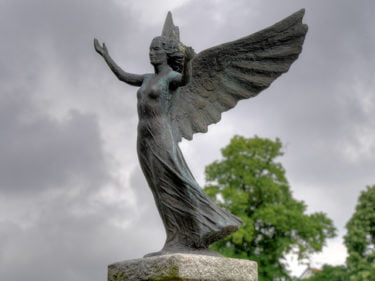This article originally appeared in The Skeptic, Volume 18, Issue 2, from 2005
In the first article in this series, I explained the origins of the fabled Angels of Mons, and the myths that rose around them. However, none of the mythmaking that took place during the First World War was new or unique – the themes that are present in the Angels of Mons reports are echoed in other myths, at various other points in history.
One rumour that multiplied during the war was the story of Russian soldiers being transported, late at night, from Scotland to the Southeast of England to fight at the front. Unnamed commuters would report seeing train carriages full of fierce, furry-hat-wearing men, with snow on their boots, on their way to the front to overwhelm the Germans. History proved this rumour to be false (Terraine, 1980).
After the destruction of the World Trade Centre, a piece of urban folklore sprang up expressing British and American anxiety about possible Muslim terrorists walking among them. A ‘friend of a friend’ (foaf ) helps an Arabic or Asian stranger who is short of money in a supermarket queue (£1 Birmingham, £3 in London). The stranger thanks them and rewards them with some advice: the ‘foaf ’ should not use the London Underground or go into Birmingham town centre, presumably due to an imminent threat. This story was repeated featuring Coventry, Tamworth, Milton Keynes and Chester (Mikkelson, 2002a).
In American versions the warning is “Don’t drink Coke this summer”, or after “June 1st 2002” (Mikkelson & Mikkelson, 2002). Or it’s an American girl whose Afghan boyfriend disappeared on September 11th 2001 is left a letter begging her not to fly on that day and to keep away from shopping malls the following Halloween (Mikkelson, 2002b). The details change, but the themes recur.
Men in White
The Angels of Mons, as they emerged during and after 1915 and in numerous books afterwards, are a folktale. They are more dazzling than snowy Russians or helpful terrorists, but an urban legend all the same. In all accounts the BEF, fighting on the side of God, King and Country, are about to be wiped out by a greater force of supposedly godless Germans. At a crucial moment a shining white figure, or figures, appears between them causing the Germans to either flee in terror or hesitate in confusion. The British use this to escape or rally enough to fight back successfully. Often in the story a captured German, usually an officer, would either ask the identity of the invincible figure in white or simply know that they had been beaten by angels.
This contrasts with The Bowmen and the Rudyard Kipling story The Lost Legion, which Machen based The Bowmen on. In both, soldiers are aided in their time of need by supernatural entities that kill the opposition. There is no mass vision or enquiring enemy; the only person to see the bowmen is the delirious Latin scholar. One exception is the account in The Universe on 30 April 1915 which does describe supernaturally inflicted death (see Part One), but this is the first known Mons account and the most influenced by The Bowmen. There were no woundless Germans dead at Mons, so the story survived because of the move from dead Germans to scared ones. Through this process the Angels of Mons came to resemble, or show the influence of, stories from elsewhere.
During the Angels of Mons debate a letter appeared in The Daily Mail on the 7 August 1915 from Lionel Edwards of Little Leigh Vicarage, Northwich. The letter suggested that events at Mons were not so surprising, as similar events had taken place before. It contained two stories, the first describing the besieged British Embassy in China during the Boxer rebellion. To get to safety the British had to risk coming into view of the Boxer snipers. At the crucial moment the snipers did not fire. When captured rebels were later asked why they did not shoot they said, as did the apocryphal captured Germans, that they were afraid of the people in white between them and the British. The second story tells of an Australian priest giving the last rites to a condemned prisoner. The prisoner claimed to have seen the priest many years ago riding alone through the bush and decided to murder and rob him. He was prevented by the “companions in white who rode either side” of the priest, who remembered being in the area on that date.
When Attila the Hun met Pope Leo I at the city gates of Rome, St Peter and St Paul appeared either side of Leo, threatening Attila with instant death if he attacked the holy city. Attila withdrew. When St Francis Xavier met the Badagars, who intended to kill Xavier and destroy the Christians of Traunancor and Comorinum, he was accompanied by a “terrible giant” with lightning in his eyes, who caused the Badagars to retreat (Brewer, 1884).
China is the venue of angelic intervention in a story repeated by Hope Price in Angels. A city is being looted by a lawless Chinese army, also threatening a missionary compound. A missionary soothes her comrades with Psalm 91:5 and the next day many non-Christians arrive at the mission to ask who their protectors were. The Missionary hears of four tall, non-Chinese (of course) soldiers guarding the mission compound. They were said to have “shone” (Price, 1994, pp. 166-167).
Missionary Sudar Singh was saved in the same way when cornered in a cave by Tibetan villagers angry with his preaching. They stood at the mouth of the cave, calling to Singh to tell them who the men were who were guarding him. Singh could see no one (Schlink, 1985). The astrally-projected spirit of a tribal medicine man was repelled by “strong men in white” when it was sent to trouble another missionary (Schlink, 1985, p. 115).
Saints, as well as angels, have aided outnumbered Christians before the retreat at Mons. Sir Walter Scott, in his Letters on Demonology and Witchcraft recounts the story of Cortez battling against extreme odds during the conquest of Mexico. St Iago was said to appear at the front of the Spanish on a white horse to lead them on to victory. Scott’s source, Historia Verdadera by Don Bernal Dias del Castillo, reports a witness remembering: “[N]ay, that he beheld an individual cavalier, named Francisco de Morla, mounted on a chestnut horse, and fighting strenuously in the very place St Iago is said to have appeared.” (Scott, 2001, p. 15).
Save the Children
Another Saint to intervene during warfare is Padre (now Saint) Pio. This legend is of interest for two reasons. Firstly, it is a post-Mons account of divine intervention and the attackers driven away were, ultimately, on the winning side. The basic motifs are still the same. During World War Two the American air force were bombing the towns of southern Italy with the exception of San Giovanni. A sky-born apparition of a monk with upheld hands was appearing to the American pilots and a ‘force field’ was stopping any bombs hitting the town. An unnamed American Commanding General, who had seen the vision, went to the town after the war to investigate and meet Padre Pio at a monastery. He recognised Pio as the air-borne monk who had protected San Giovanni, and just as non-religious men were changed after seeing the Angels of Mons, the General knelt before Pio and converted to Catholicism soon afterwards (Day, 2002).
Another branch of this myth substitutes embattled Christian men with children. The book Angels A to Z repeats two incidents of angelic intervention that took place after Mons (Merta, 1996). There is the possibility of a kind of narrative contamination from the Mons legends but I feel there are enough pre-20th century predecessors, St Iago in Mexico, Attila at the gates of Rome and St Francis Xavier being three examples, to demonstrate that all these stories have a common root far older than Arthur Machen’s story in London Evening News.
The first is during the Second World War in Danzig, East Prussia (now Gdansk, Poland). A group of children are sheltering in a schoolhouse from Russian shelling. One of the children who, like many of the angel witnesses, is not a Christian, says “It came up to here on them” to a nurse while tapping his breastbone. When asked what he meant, the boy described men who were standing at every corner of the building, ablaze with light and so tall the gutters of the roof came up to their chests.
The second account describes missionary children trapped during the Jeunesse Rebellion in the Congo as rebel troops advance on their school. The rebels spend three days advancing, then inexplicably retreating and, of course, when a wounded rebel is captured, he tells of hundreds of soldiers dressed in white, protecting the compound that contained the school (Merta, 1996).
There is at least one earlier version of this story. In Kendal, Cumbria in 1745, Highland raiders are prevented from seizing a child they find playing on the floor of an inn parlour by an angel who drives them away. The event is said to have given the Angel Inn of Kendal its name (Findler, 1984).
Inevitably a version appears in one Mons account. A member of the British Expeditionary Force rescues a child from the Germans. A nurse asks him how he did it, he replies:
How did you manage to pick up the child from under the German guns?” I asked. […] “It was a kind of Golden cloud between us and the Germans and a man on a big horse – and then I saw the child in the dust by the roadside, and picked it up.” “Yes sister,” he added, “Lots of the other chaps saw it too.” There was a murmur of confirmation. “The minute I saw it,” he continued, “I knew we were going to win. It fair bucked me up.
McClure, 1983, p. 9
Angels intervene in the Bible, Exodus 14:19. Just before the Red Sea is parted, the fleeing Israelites are saved by the Angel of God within a glowing cloud that “lit up the night” coming between them and Pharaoh’s army. As with some British troops who reach their wits end at Mons, in Exodus 14:11 the Israelites ask Moses, “Was it because there were no graves in Egypt that you have taken us away to die in the wilderness?” as Pharaoh’s cavalry bears down on them. In 2 Maccabees 3:254-26 the Temple is saved from a rampaging mob in the familiar way. “For there appeared to them a magnificently caparisoned horse, with rider of frightening mien; [….] its rider was seen to have armour and weapons of gold.” The mob fall back in terror, and two further defenders sent by the “Sovereign of Spirits” appear and flog the leader of the mob.
It is clear to me that the Angels of Mons follows the same pattern as all of the examples above. Outnumbered Christians escape certain harm by divine intervention. Often the events are backed by an enquiry into the supernatural events from the attackers. After some shifting from the initial accounts, inspired by visions in the field or The Bowmen or both, the shape the Mons stories settled into is one of established Christian folklore.
Elsewhere
Do not let it be thought that these stories are exclusively Judeo-Christian, however. While the motif of the enemy fleeing in fear or confusion without engaging the supernatural Guardians is an element of the Christian version of the story, there are parallels in other faiths and myths.
The first major victory in the campaigns led by Muhammad was won at Bedhr, when the greatly outnumbered Muslims were joined in their battle against the Meccans by the angel Gabriel leading an army of angels. Two observers on a hill heard the angels’ stallions neigh as they swept past and saw them moving in a cloud. One of the men died of fright on the spot (Glassé, 1989, pp. 66-67).
No doubt evolving from the Bible stories but with a Celtic influence is the folktale of the Faery Flag of the MacLeods. A battle between the MacLeods and MacDonalds is going badly for the MacLeods until the flag is waved and it seems as if their numbers are greatly reinforced, and the MacDonalds faltered and fell back (Wilson, 1971, p. 71). Gerald B. Gardner tells a similar story about a battle on the Isle of Man (Gardner, 1975, p. 64).
The 14th of August 1915 issue of Light carried a de-Christianised version of the white rider myth is its Sidelights section:
We observe that the ghost of the celebrated General Skobelev, who made so great a mark in the Russo-Turkish war of 1877, is reported in a telegram [….] to have been seen of late by many Russian sentries. The apparition appeared clad in a white uniform and riding a horse. According to an exchange its appearance is stated by tradition to mark always a critical moment for the armies of the Czar, and to cause invariable panic in the enemies ranks.
Further back than the visions of St Iago in Mexico, St George at Carthage, and Mons and General
Skobelev, is the story of twin gods Castor and Pollux, appearing before Roman soldiers at the Battle of Lake Regillus in 496 BC. The horse-riding Dioscuri, as they were known in Greece, led the Romans to victory against the Etruscan Tarquins and became patrons of the Roman cavalry (Grant, 1996).
In 174 AD, another Roman force, trapped, thirsty, tired and greatly outnumbered, were given water by divine intervention, restoring them sufficiently to gain victory. The miracle was ascribed to both Mercury and later to the Christian God, the pagan version requesting the miracle via an Egyptian magician, the Christian by prayer (Mullin, 1978).
The Iliad, like the Bible, contains a number of divine interventions. Athene directs an arrow fired at Menelaus toward his metal belt, though the bolt still floors him. Apollo hides Prince Hector and Agenor from Achilles in a golden cloud and a cloud of smoke respectively, while Poseidon spreads a mist before Achilles’ eyes and takes Aeneas to safety (Homer, 1950).
Artemis is a Greek hunter goddess who appears in the Iliad, though her origins disappear into pre-history. In The Encyclopaedia of Religion she is described in a way that sounds very much like the Angels of Mons and their kin:
Artemis does not fight; she guides and she saves, she is Artemis Hegemone (‘ruler’) and Artemis Soteira (‘saviour’). She is invoked as rescuer in critical situations when a city is threatened with complete destruction. Artemis prepares for action when war goes beyond the civilised rules of combat and veers in the direction of savagery. In these extreme cases the goddess does not resort to physical or martial force, but uses supernatural means to upset the game. To some she brings blindness, leading them in out-of-the-way paths, while others she gives a sort of hyper-lucidity, guiding them miraculously through darkness or illuminating their minds with sudden inspiration.
I do not think the original story of these supernatural saviours will be identified. The story clearly goes back thousands of years and has been adapted by numerous cultures and creeds. The angels, saints, gods and goddesses act by causing confusion, terror and sudden courage, by bringing down smoke clouds and bright lights. Their perceived actions are really what happens in a battle and what happens in the human mind during that battle. It is in the chance, chaos, smoke, flames and visions of humanity and humanity’s environment that we see the faces of the divine and build our stories around them, stories that spread, grow and evolve according to human time and place.
References
- Brewer, Rev F. Cobham. (1884). A Dictionary of Miracles. London: Chatto & Windus.
- Day, M. (2002). Blood Brother. Fortean Times, 162, 35–38.
- Eliade, M. (1987). The Encyclopedia of Religion, Vol 1. New York: MacMillan.
- Findler, G. (1984). Lakeland Legends. Clapham: Dalesman Books.
- Gardner, G. B. (1975). Witchcraft Today. London: Arrow Books.
- Glassé, C. (1989). A Concise Encyclopaedia of Islam.London: Stacy.
- Grant, M. (1996). History of Rome. London: Weidenfeld & Nicolson.
- Homer (trans. 1950). The Iliad (trans. E.V. Rieu). London: Penguin.
- Howarth, P. (1994). Attila, King of the Huns: Man and Myth. London: Constable.
- Merta, M. F. (1996). Battlefield, Angels on the. In R. L. James, & E. D. Oliver (with K. S. Sisung), Angels A to Z. Detroit: Visible Ink.
- McClure, K. (1983). Visions of Bowmen and Angels. Retrieved 12 April 2002
- Mikkelson, B. (2002a). Stalk Tip. Retrieved 18 May 2003, from http://www.snopes.com/rumors/warning.htm
- Mikkelson, B. (2002b). Mall Risk. Retrieved 18 May 2003, from http://www.snopes.com/rumors/mallrisk.htm
- Mikkelson, B., & Mikkelson, D. P. (2002). Not the Real Thing. Retrieved 18 May 2003, from http://www.snopes.com/rumors/cocacola.htm
- Mullin, R. (1978). Miracles and Magic: The Miracles and Spells of Saints and Witches. Oxford: Mowbray.
- New Revised Standard Version Bible. (1989). Oxford: Oxford University Press.
- Price, H. (1994). Angels. London: Pan
- Schlink, B. (1985). The Unseen World of Demons and Angels. London: Marshall Morgan & Scott.
- Scott, Sir W. (2001). Letters on Demonology and Witchcraft. London: Wordsworth.
- Terraine, J. (1980). The Smoke and the Fire. Myths and Anti-Myths of War 1861-1945. London: Sidgewick and Jackson.
- Wilson, B. K. (1971). Scottish Folk-Tales and Legends. Oxford: Oxford University Press.










